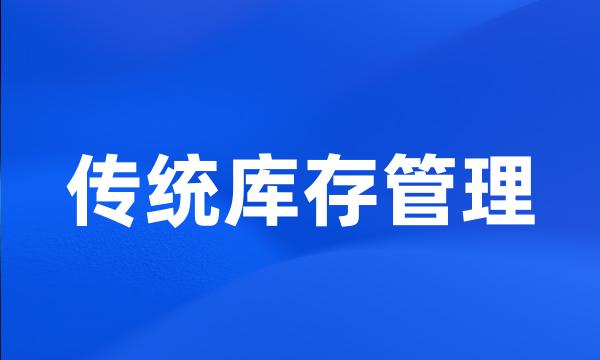传统库存管理
 传统库存管理
传统库存管理-
最后,针对关键商品、瓶颈商品、重要商品、常规商品的特性,将其与CPFR、JMI、VMI、传统库存管理模式进行匹配,充分体现了差异化品类管理的思想。
Finally , according to the characteristics of key commodity , bottleneck commodity , important commodity and common commodity , we use the idea of category management to match them with CPFR , JMI , VMI and tradition inventory management .
-
传统库存管理方式的弊病与漏洞
Disadvantages and Loopholes of Traditional Inventory Management
-
第二部分:供应链管理环境下的库存问题。重点是在理解传统库存管理方法的基础上分析供应链管理环境下出现的库存管理的新问题。
Part 2 : focus on the analyses on the problems of the inventory under supply chain management environment .
-
对仿真结果做了定量比较,从结果可以看到传统库存管理方法会产生较严重的牛鞭效应。
It can be concluded that using traditional inventory management methods can cause serious bull whip effect by comparison of the simulation results .
-
对供应链中的不确定性和存在的牛鞭效应进行分析和探讨,并指出传统库存管理方式存在的弊端和问题。
The uncertainty and the Bull-whip Effect under SCM have been discussed in this paper , so does the shortcomings of the traditional IM method . 3 .
-
结合高新技术并且高度合作的两种库存管理模式,与传统库存管理相比,确实能够缓解牛鞭效应,但并不能完全消除。
Compared with the traditional inventory management model , the two of high-tech and high-cooperated inventory management models indeed decrease the bullwhip effect , but not completely eliminated .
-
为有效解决传统库存管理模式中物流、信息流、资金流相互脱节和信息传递不对称的的问题,提出在移动通信企业内部建设“物流-资产”一体化信息系统的设想。
This paper investigates the information of the supply chain management , presents the VMI model based on information-integrated , and introduces the framework and functions of the system .
-
传统库存管理系统的分析功能的局限性,阐述基于数据仓库的联机分析和决策支持的优势。
Introduce the limitations of the normal inventory management system , and introduce the advantages of the decision support system ( DSS ) based on data warehouse . 3 .
-
以分销商、零售商和终端客户组成的供应链为对象系统,建立了供应链传统库存管理方法的系统动力学模型,对模型进行了系统动力学的相关测试与仿真。
For a supply chain made up of distributors , retailers and final customers , system dynamic models are constructed using traditional inventory management methods , which are tested and simulated .
-
供应商管理库存是供应链管理环境下库存控制的一项重要策略,它有效地克服了传统库存管理模式下的牛鞭效应等问题,提高了供应链系统的运作效率和整体竞争力。
Vendor Managed Inventory ( VMI ) is a new and representative supply chain inventory management tactic , which overcomes the Bullwhip effect of the traditional stock control mode availably and improves the operation efficiency and competitiveness of the supply chain .
-
随着消费者行为习惯不断改变,产品的生命周期逐渐缩短,来自市场的需求不确定性日趋增大,传统库存管理模式已经无法满足现代零售企业对低成本、高服务水平的要求。
With the consumer habit changing , the product life cycle is gradually shortened and the demand uncertainty from the market is increasing day by day . The traditional inventory management has been unable to meet the requirement of low-cost and high service for the modern retail .
-
本文在详细分析AD公司及其库存状况的基础上,首先运用传统的库存管理方法对AD公司的库存进行了优化,并进一步提出通过供应链管理的方法来降低饲料企业的库存。
In the basis of analysis the inventory of AD Company , this paper improves the inventory situation with traditional methods of inventory management . And more , this paper tries to low the inventory of feed enterprise with the methods of supply chain management .
-
第三章简单地介绍了库存的基本理念和传统的库存管理模式,并进一步提出了在供应链下的几种库存管理模式,诸如供应商管理库存VMI、联合管理库存JMI等。
Chapter Three includes the basic theory of inventory and the descriptions on the traditional inventory management models ; in addition , it puts forward several models in the supply chain , such as Vendor Managed Inventory ( VMI ), Jointly Managed Inventory ( JMI ), etc.
-
供应链思想的出现为传统的库存管理指明了新的发展方向。
The appearance of SCM indicates a new development direction for the traditional inventory control .
-
它与制造业传统的库存管理理论有很大的不同。
This is drastically different from traditional stock management theories applying to the manufacturing industry .
-
在知识经济时代,传统的库存管理思想已经不能满足市场发展的需要,强调供应链整体合作是库存理论的进一步发展趋势。
In the knowledge time , the traditional inventory management ideas have been cannot satisfy the requirement of market development .
-
然而传统的库存管理方式,造成联想国际高库存,高过剩库存,以及导致高成本的困境。
However , the traditional inventory management , resulting in high inventory in Lenovo International , the high excess inventory , lead to high costs .
-
传统的库存管理主要把注意力放在企业内部的库存控制,不注重供应链的协调与合作。
The traditional inventory management dominantly pays attention to the internal inventory control of business , and is neglectful on supply chain coordination and partnering .
-
本文分别对传统的库存管理运作模式,和供应链环境下的现代库存管理模式进行了讨论。
In this paper , we discuss the mode of operation of the traditional inventory management , and the modern inventory management model in supply chain .
-
由于传统的库存管理只是针对单个企业而言,这些理论与方法难以适应供应链管理环境的要求。
Because the traditional inventory management just aims at the single enterprise , these theories and methods can not meet the request of supply chain management environments .
-
在供应链管理不断发展和完善的今天,传统的库存管理方法已明显暴露出其不适应供应链环境的缺陷。
Today the supply chain management uninterrupted growth and perfection , traditional inventory management method distinct emerge the limitation which can not adapt the supply chain management circumstance .
-
鉴于混合系统库存管理固有的复杂性、运作的独特性,以致客观上要求对传统的库存管理理论和方法进行修正。
Due to the inherent complexity and particular operation of inventory management in the hybrid system , the modification of the traditional inventory management theories and methods are required objectively .
-
随着企业组织和管理模式的变化,供应链环境下库存控制同传统的库存管理相比,有许多不同之处。
With the changes of enterprise structure and management mode , more requires and new characteristics exit in Supply Chain Management , compared with the traditional method of inventory management .
-
同样,在其快速的成长发展过程中,由于缺乏对企业供应链管理的系统研究,依然沿用传统的库存管理方式,库存管理问题显得较为突出。
Similarly , in its rapid growth and development process , due to the lack of study on enterprise supply chain management system , it has been using traditional inventory management .
-
以此同时,传统的库存管理方法很难改变这种状况,于是近年来,产生了一种新的库存管理方法&供应商管理库存。
Such sort of situation could hardly be transformed by traditional inventory management . A new inventory management method has been arose in recent years in this way & Vendor Managed Inventory .
-
在传统的库存管理模型中,研究者大都假设产品质量是100%完好的、产品的市场需求为已知常数,然后根据要求确定生产或订购批量。
For the traditional inventory management models , researchers always assume 100 % of items in an ordered lot are perfect and the demands is constant value , then make decision to the production or ordering lot sizing .
-
传统的库存管理只是针对单个企业而言,侧重于优化单一的库存成本,从存储成本和订货成本出发确定经济订货量和订货点,这些理论与方法难以适应供应链管理环境的要求。
Traditional inventory management only face to individual enterprises , focus on the optimization of a single inventory costs , economic order quantities and order starting point are established on storage and order costs , the theory and methods can 't adapt to the supply chain management environment .
-
从库存的基本概念,传统库存控制管理方法,到供应链环境下的多级库存控制问题等多方面入手,重点讨研究了物流运作中多级库存、仓库间优化调度问题。
From the basic concepts of inventory , inventory control and management methods traditional to the supply chain environment many of the class , such as inventory control problem a multi-pronged approach , focusing on research to discuss the logistics of multi-level inventory , storage between the optimal scheduling problem .
-
根据传统的生产库存管理理论,针对化工企业生产资料库存存在问题,分析该企业生产资料库存的特点,制定合适库存策略,并且对简单EOQ模型修正与应用进行阐述。
According to traditional production stock management theories , aim at the chemical industrial enterprise stock problem , analyzing the characteristics that business enterprise produce data stock , establish the fit stock strategy , and revise to proceed with application to expatiate to the simple EOQ .
-
传统及现在库存管理理论及方法的介绍;
Following is the main contents of this paper : ( 1 ) A introduce to classical and modern inventory techniques ;
